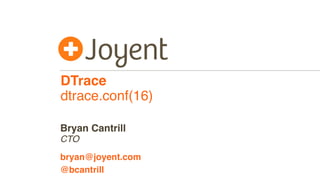dtrace.conf(16): DTrace state of the union
- 2. dtrace.conf(16) ŌĆó Quadrennial (!) DTrace unconference started in 2008 ŌĆó ~100 attendees from: ŌĆó ~45 companies ŌĆó ~1 VC Entrepreneur-in-Residence ŌĆó Twitter: #dtraceconf ŌĆó Thanks to our sponsors, Joyent ŌĆö and the FIPP! ŌĆó Huge thanks to Ryan Wilson, Brittany Berry and Jenny Miller from Joyent
- 5. DTrace since 2012 Same haircut
- 6. DTrace since 2012 Same glasses?
- 9. DTrace since 2012: Core ŌĆó Added new ways of representing aggregated data via ŌĆ£agghist,ŌĆØ ŌĆ£aggpack,ŌĆØ and ŌĆ£aggzoomŌĆØ options ŌĆó Added new json() subroutine ŌĆó Added DTrace userland CTF support ŌĆó Added the new (on-by-default!) ŌĆ£temporalŌĆØ option ŌĆó Added print() support for translated types ŌĆó Added support for fds[], curpsinfo, sched and proc providers in a zone container
- 10. DTrace since 2012: Platforms ŌĆó FreeBSD implemented the pid provider in 9.0 and, as of 9.2, enabled DTrace by default! ŌĆó NetBSD added DTrace support ŌĆö including support for ARM! ŌĆó Linux port of DTrace largely completed by Oracle ŌĆö but keeping the user-level portion proprietary has limited its impact
- 11. DTrace in 2016 and beyond ŌĆó Distributed systems are ubiquitous and tracing in distributed systems has improved tremendously; how can DTrace help? ŌĆó Instrumenting multi-processes applications via the pid provider is still painful; can we improve? ŌĆó The rise (resurrection?) of statically compiled languages like Go and Rust presents new opportunity ŌĆö and new challenges ŌĆó DTrace and serverless computing? ŌĆó User-level postmortem tracing? ŌĆó Anti-roadmap: Dynamic translators?
- 12. dtrace.conf(16)!
- 15. Welcome, Trolls!








![DTrace since 2012: Core
ŌĆó Added new ways of representing aggregated data via ŌĆ£agghist,ŌĆØ
ŌĆ£aggpack,ŌĆØ and ŌĆ£aggzoomŌĆØ options
ŌĆó Added new json() subroutine
ŌĆó Added DTrace userland CTF support
ŌĆó Added the new (on-by-default!) ŌĆ£temporalŌĆØ option
ŌĆó Added print() support for translated types
ŌĆó Added support for fds[], curpsinfo, sched and proc providers
in a zone container](https://image.slidesharecdn.com/dtracedotconf2016-180204024634/85/dtrace-conf-16-DTrace-state-of-the-union-9-320.jpg)





